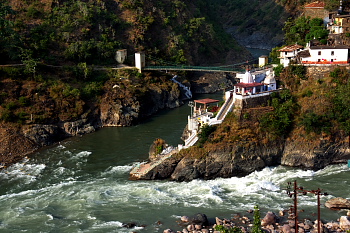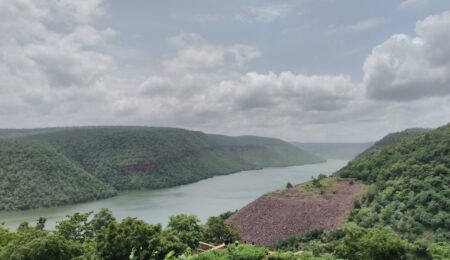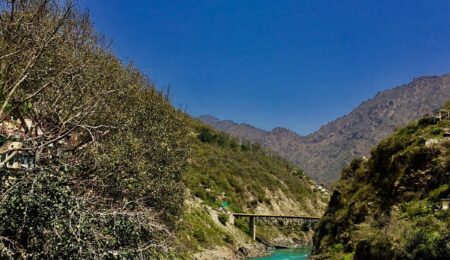 Flowing through the picturesque landscapes of Uttarakhand, the Mandakini River is a divine waterway with deep spiritual significance. Nestled in the lap of the Himalayas, this holy river originates from the glacial meltwaters near Kedarnath, one of India’s most revered pilgrimage sites. Journeying through the rugged terrain of the Garhwal region, the Mandakini River enchants pilgrims and nature enthusiasts alike, leaving an indelible mark on their hearts and souls.
Flowing through the picturesque landscapes of Uttarakhand, the Mandakini River is a divine waterway with deep spiritual significance. Nestled in the lap of the Himalayas, this holy river originates from the glacial meltwaters near Kedarnath, one of India’s most revered pilgrimage sites. Journeying through the rugged terrain of the Garhwal region, the Mandakini River enchants pilgrims and nature enthusiasts alike, leaving an indelible mark on their hearts and souls.
The Mandakini River derives its name from the mythical apsara (celestial nymph) named Mandakini, who is said to have descended from the heavens to bless the land with her presence. The river meanders through the scenic valleys, gushing through rocky gorges and serene meadows. It joins the Alaknanda River at Rudraprayag, where the confluence of these two sacred rivers creates a powerful spiritual energy that draws devotees from across the country.
The Mandakini River is best known for its association with the holy town of Kedarnath, one of the twelve Jyotirlingas (sacred abodes of Lord Shiva). According to Hindu mythology, Lord Shiva himself is believed to have manifested as a lingam (phallic symbol) at Kedarnath. The river flows close to the Kedarnath temple, adding to the spiritual aura and creating an ethereal ambiance that resonates with devotees. The river has great religious significance for Hindus and is considered a holy place. Hindus believe that bathing in the river will cleanse them of their sins. The river is also a popular place for pilgrims to visit.
The Mandakani River is also an important scientific site. The river is home to a number of rare and endangered species of fish, amphibians, and reptiles. The river is also a critical part of the water cycle in the region. The Mandakani River is a major tributary of the Ganges River. The river is approximately 1,600 kilometers (1,000 miles) long. The river originates in the Himalayan Mountains and flows through Uttarakhand, Uttar Pradesh, Bihar, and West Bengal.
The Mandakani River is an important source of water for irrigation and drinking water for millions of people. The river is also a critical part of the water cycle in the region. The Mandakani River is home to many rare and endangered fish species, amphibians, and reptiles. The river is also a critical part of the water cycle in the region.
 A pilgrimage to Kedarnath and the banks of the Mandakini River is considered a journey of spiritual awakening and transformation. Devotees undertake arduous treks and endure challenging terrain to reach the temple, seeking the blessings of Lord Shiva. The pristine waters of the Mandakini River are considered sacred, and pilgrims often take a holy dip to purify themselves before entering the temple premises. The pilgrimage experience is imbued with devotion, faith, and a deep connection to the divine.
A pilgrimage to Kedarnath and the banks of the Mandakini River is considered a journey of spiritual awakening and transformation. Devotees undertake arduous treks and endure challenging terrain to reach the temple, seeking the blessings of Lord Shiva. The pristine waters of the Mandakini River are considered sacred, and pilgrims often take a holy dip to purify themselves before entering the temple premises. The pilgrimage experience is imbued with devotion, faith, and a deep connection to the divine.
Besides its religious significance, the Mandakini River is also an integral part of the region’s ecosystem and supports diverse flora and fauna. The river serves as a lifeline for the local communities, providing water for irrigation, agriculture, and sustenance. The fertile soil along the riverbanks facilitates the cultivation of crops like wheat, rice, and potatoes, contributing to the local economy and livelihoods.
The Mandakini River and its surroundings are blessed with unparalleled natural beauty. The snow-capped peaks, dense forests, and breathtaking vistas create an idyllic setting that captivates visitors. The river is surrounded by several picturesque spots, including Chorabari Tal (Gandhi Sarovar), Vasuki Tal, and Sonprayag, which offer scenic views and tranquil retreats for those seeking solace in nature.
The Mandakani River is also an important source of fish for the local people. The river is home to various fish species, such as the Mahseer, Catfish, Carp, and Barb. The river is also a popular spot for bird watching. Various bird species, such as the Kingfisher, Pelican, and Heron, can be seen in the river. The Mandakani River is also an important ecological resource. The river is home to a variety of plants and animals. The river is also a major source of food for the local people. The Mandakani River is also an important income source for the people in its vicinity.
The Mandakani River is also an important water source for the people in its vicinity. The river is also a major source of irrigation for the farmers in the region. The Mandakani River is also a major source of hydroelectric power for the region. The river has been dammed for this purpose, and the resulting reservoir is known as the “Mandakani Hydroelectric Power Plant”.
However, the Mandakini River and its fragile ecosystem face challenges, including environmental degradation and the effects of climate change. The rise in pilgrimage and tourism activities has put pressure on the river’s resources, leading to pollution and deforestation. It is crucial to raise awareness and implement sustainable practices to preserve the pristine nature of the Mandakini River and protect its delicate ecosystem.
 Visiting the Mandakini River is an opportunity to witness the harmonious blend of spirituality and natural splendor. The serene ambiance, the rhythmic flow of the river, and the surrounding majestic mountains evoke a sense of awe and reverence. It is a chance to connect with the divine, find solace in nature’s lap, and experience the profound energy that permeates the atmosphere.
Visiting the Mandakini River is an opportunity to witness the harmonious blend of spirituality and natural splendor. The serene ambiance, the rhythmic flow of the river, and the surrounding majestic mountains evoke a sense of awe and reverence. It is a chance to connect with the divine, find solace in nature’s lap, and experience the profound energy that permeates the atmosphere.
In conclusion, the Mandakini River is not just a waterway; it is a sacred embodiment of divinity and a testament to the awe-inspiring power of nature. It is a reminder of the delicate balance between human beings and the environment, urging us to protect and preserve the sanctity of this holy river. As we undertake our spiritual journeys and explore the majestic beauty of the Mandakini River, let us do so with gratitude, mindfulness, and a deep sense of responsibility toward preserving this precious natural and spiritual heritage.



